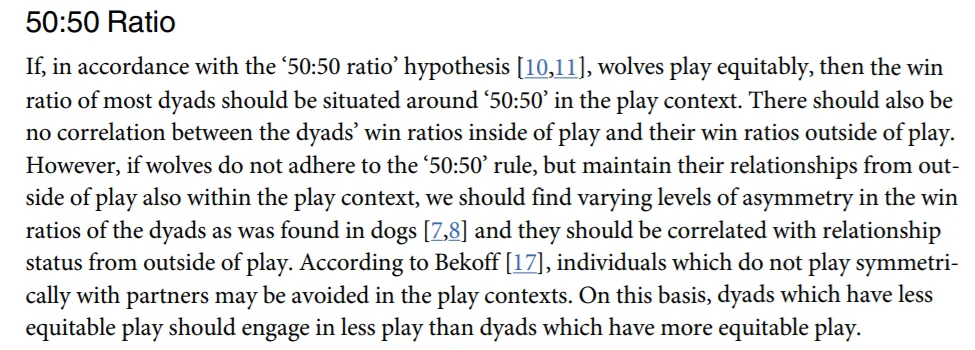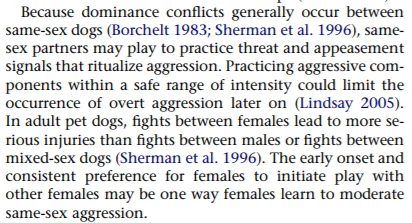Studies:
Wolves:
Play Behavior in Wolves: Using the ‘50:50’ Rule to Test for Egalitarian Play Styles, 2016
In Wolves, Play Behaviour Reflects the Partners'; Affiliative and Dominance Relationship, 2018
Dogs:
Dogs (Not open access!)
Cooperation and competition during dyadic play in domestic dogs, Canis familiaris, 2007
Objectives to discuss:
-
Purpose of playing?
-
Pups
-
Adults
-
-
What is a big generalization being tested?
-
Is there much more to be learned through play when interpreting canine behavior?
-
-
What was being tested in these studies?
-
What were the results?
-
How may this information be useful to us as dog trainers?
Play Behavior in Wolves: Using the ‘50:50’ Rule to Test for Egalitarian Play Styles, 2016
- The 50:50 rule
- What is it?
- "both playing individuals show ‘winning’ behaviors, such as chasing or play biting, equally often. It
has been suggested that behaviors such as ‘role-reversing’ and so-called ‘self-handicapping’ can
be used to maintain equality and thus continue social play [12]. A ‘role reversal’ is defined as
when an individual which is dominant to its partner outside of the play context displays a
behavior during play that it would not normally adopt in an agonistic interaction, such as muzzle-licking in dogs [12]." - "social self-handicapping, when a stronger partner takes a disadvantageous position"
- "both playing individuals show ‘winning’ behaviors, such as chasing or play biting, equally often. It
- Was it true?
- Between pups - Is it a testing behavior? Reduce aggressive behavior later on?
- Between adults
- Between mix aged?
- Between different sexes?
- What is it?
In Wolves, Play Behaviour Reflects the Partners’ Affiliative and Dominance Relationship, 2018
Puppy packs (consisting of only puppies) and mixed-age packs (composed of puppies and adults) were observed to test whether social play can be used for assessing and establishing social relations in wolves, Canis lupus. Differently from previous studies, we looked at play behaviours in detail, allowing us to categorize play interactions as either competitive or relaxed, and predicted that different types of play would be associated with different relationships between individuals. We found that the more time dyads spent in relaxed play, the more affiliative interactions they exchanged outside of play. In the mixed-age packs, dyads that spent more time in both relaxed and competitive play showed fewer exchanges of aggressive behaviours. Conversely, in puppy packs, the more time dyads spent in competitive play, the more aggressive interactions were exchanged outside of play. Since clear dominance relationships emerged in the mixed-age packs, but not in puppy packs, we suggest that play can help to reduce the frequency of aggressive interactions only when a clear hierarchy exists between pack members. Furthermore, we found that in both puppy and mixed-age packs, dominance relationships were reflected and rarely reversed during play. Finally, dyads with a less clear dominance relationship spent more time playing in a competitive way. Overall, our results support the social assessment hypothesis suggesting that social relationships outside of play are reflected during playful interactions. Moreover, we revealed how different types of play, that is, playing in a competitive or relaxed way, may be related to different social relationships. This distinction between play types has not been acknowledged before but could help researchers better understand the functions of play in different species.
Partner preferences and asymmetries in social play among domestic dog, Canis lupus familiaris, littermates
- "Puppies did not adhere to the 50:50 rule in any time
period; however, play was more symmetrical between very
young littermates and became less so as the puppies
matured."
Cooperation and competition during dyadic play in domestic dogs, Canis familiaris. Published 2007
From the abstract (full study not open access):
"Social play involves a dynamic combination of competition and cooperation, yet few studies have systematically evaluated the cooperative side of play. We studied dyadic play in domestic dogs to investigate factors influencing variation in cooperative play strategies like self-handicapping and role reversal. Dyadic play bouts were videotaped and coded for asymmetric behaviours. We predicted that variation in play style would reflect salient aspects of the canine social system, including dominance relationships and age and size differences, but not sex differences. Our results refute the 50:50 rule proposed by some researchers, which asserts that participants must equalize their behaviour to maintain a playful atmosphere. We observed divergence from 50:50 symmetry to varying degrees across dyads. This variability was especially linked to dominance and age advantages, such that higher-ranking and/or older dogs generally showed higher proportions of attacks and pursuits and lower proportions of self-handicapping than their disadvantaged play partners. These results contradict the notion that more advantaged individuals consistently relinquish their advantage to facilitate play. Role reversals did occur, but certain social conventions apparently dictated which behaviours could be used during role reversals. For example, role reversals occurred during chases and tackles, but never during mounts, muzzle bites or muzzle licks, suggesting that these latter behaviours may be invariant indicators of formal dominance during play in domestic dogs. Play signalling was linked to self-handicapping behaviour but not to attack/pursuit behaviour, indicating that perhaps self-handicapping and play signalling work together to communicate playful intent and reinforce existing roles."
How may this information be useful to us as dog trainers?
- Evaluating puppy play
- puppy socialization classes
- client questions with new puppies and existing dogs
- Estabilishing relationships in non-aggressive ways with adult dogs
- Maintaining proper relationships with dogs
- Protection training
- handler play
- agitator play




Responses